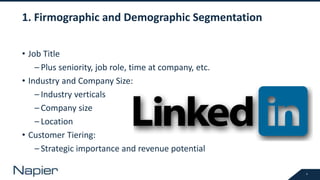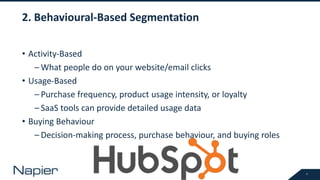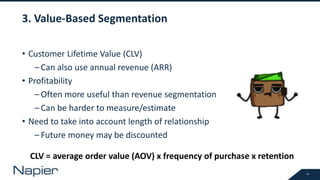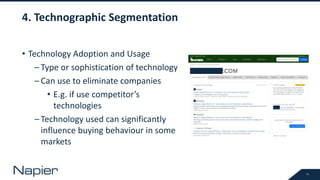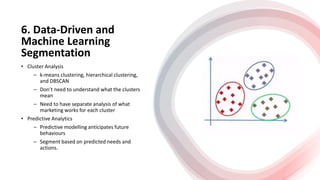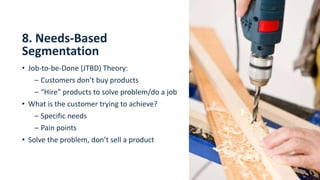Segmentation Secrets: 9 Ways to Target the Right Audience
- 1. SEGMENTATION SECRETS: 9 WAYS TO TARGET THE RIGHT AUDIENCE July 2024
- 2. 2 ŌĆ£Half the money I spend on advertising is wasted; the trouble is I donŌĆÖt know which half.ŌĆØ John Wanamaker
- 3. 3 The Webinar Segments ŌĆó How you segment today ŌĆó Why segmentation is important ŌĆó When and where you should segment ŌĆó The 9 strategic segmentations you should use ŌĆó How to implement these segmentations ŌĆó What to do if you can't segment an audience ŌĆó Key take-aways ŌĆó Q&A
- 5. 5 Why Segmentation is Important ŌĆó People who will buy ŌĆó Right company ŌĆó Right people in the company ŌĆó Companies in-market ŌĆó Right message to each segment ŌĆō By market, persona, company size, etc. How can we make our campaign more likely to succeed
- 6. 6 When Should You Segment? ALWAYS ŌĆó Advertising ŌĆó Email marketing ŌĆó Social ŌĆó Trade shows/events
- 7. The Nine Strategic Segmentations You Should Use
- 8. 8 1. Firmographic and Demographic Segmentation ŌĆó Job Title ŌĆō Plus seniority, job role, time at company, etc. ŌĆó Industry and Company Size: ŌĆō Industry verticals ŌĆō Company size ŌĆō Location ŌĆó Customer Tiering: ŌĆō Strategic importance and revenue potential
- 9. 9 2. Behavioural-Based Segmentation ŌĆó Activity-Based ŌĆō What people do on your website/email clicks ŌĆó Usage-Based ŌĆō Purchase frequency, product usage intensity, or loyalty ŌĆō SaaS tools can provide detailed usage data ŌĆó Buying Behaviour ŌĆō Decision-making process, purchase behaviour, and buying roles
- 10. 10 3. Value-Based Segmentation ŌĆó Customer Lifetime Value (CLV) ŌĆō Can also use annual revenue (ARR) ŌĆó Profitability ŌĆō Often more useful than revenue segmentation ŌĆō Can be harder to measure/estimate ŌĆó Need to take into account length of relationship ŌĆō Future money may be discounted CLV = average order value (AOV) x frequency of purchase x retention
- 11. 11 4. Technographic Segmentation ŌĆó Technology Adoption and Usage ŌĆō Type or sophistication of technology ŌĆō Can use to eliminate companies ŌĆó E.g. if use competitorŌĆÖs technologies ŌĆō Technology used can significantly influence buying behaviour in some markets
- 12. 12 5. Psychographic Segmentation ŌĆó Decision-Maker Profiles ŌĆō Attitudes, values, and motivations of decision-makers within organizations ŌĆō Includes risk aversion, innovation propensity, and leadership style. ŌĆó Cultural and Behavioural Traits ŌĆō Different customers/prospects need different messages ŌĆó Personas ŌĆō Classic way to segment ŌĆō Different personas can be in the same psychographic segmentation
- 13. 13 6. Data-Driven and Machine Learning Segmentation ŌĆó Cluster Analysis ŌĆō k-means clustering, hierarchical clustering, and DBSCAN ŌĆō DonŌĆÖt need to understand what the clusters mean ŌĆō Need to have separate analysis of what marketing works for each cluster ŌĆó Predictive Analytics ŌĆō Predictive modelling anticipates future behaviours ŌĆō Segment based on predicted needs and actions.
- 14. 14 7. Customer Journey Segmentation ŌĆó Can be hard to understand stage of journey ŌĆó But weŌĆÖre familiar with simple journey segmentation ŌĆō tofu, mofu, bofu ŌĆó More granular segmentation can improve performance ŌĆó Building detailed customer journey model is most effective, (but most complex) ŌĆō Move customer along step-by-step ŌĆō Build microjourneys A I D A
- 15. 15 8. Needs-Based Segmentation ŌĆó Job-to-be-Done (JTBD) Theory: ŌĆō Customers donŌĆÖt buy products ŌĆō ŌĆ£HireŌĆØ products to solve problem/do a job ŌĆó What is the customer trying to achieve? ŌĆō Specific needs ŌĆō Pain points ŌĆó Solve the problem, donŌĆÖt sell a product
- 16. 16 9. Account-Based Marketing ŌĆó Each customer is a segment ŌĆó Allows high levels of personalisation ŌĆó One of the most popular segmentation approaches for B2B today
- 17. 17 Bonus ŌĆō Interest-Based Segmentation ŌĆó E.g. market products to people interested in them ŌĆó Can be like behavioural ŌĆō PR is an example ŌĆō (target people interested in specific magazines)
- 18. 18 What to do if You CanŌĆÖt Segment an Audience ŌĆó Start gathering data ŌĆō Enable future segmentation ŌĆó 3rd party databases ŌĆó Public databases ŌĆó Build models/journeys ŌĆó Ask using forms/track behaviour ŌĆó Test Name Email Company Name Email Name Email Job Title Company Job Title Challenge Project Start
- 19. 19 Key Take-Aways ŌĆó Segment your data! ŌĆó There is no perfect segmentation ŌĆō But some may be too hard ŌĆó Test different approaches ŌĆó Keep gathering data
- 20. 20 Our Next Webinar: How Business-to- Business Advertising Works 20th August 2024 4pm UK 11am Boston 8am San Francisco https://qrcodes.pro/tGO3eT
Editor's Notes
- #3: Wasted advertising money is simply advertising to the wrong audience (well it can be terrible ads, but John Wanamaker created the chain of stores that eventually became MacyŌĆÖs so his ads were probably OK).
- #7: ItŌĆÖs not just picking the right shows! Talk about trade shows ŌĆō booths segment by offering beer or executive meetings ’üŖ.
- #9: Company size can be revenue, number of employees, number of people at certain division, etc. Example of implementation - LinkedIn
- #10: Example of implementation ŌĆō marketing automation (e.g. email if visit a page or fill in a form)
- #11: ARR is annual recurring revenue SaaS companies typically focus on value-based segmentation ItŌĆÖs a process that is based upon research and then calculations ŌĆō do the math! Note that it can result in treating your customers like a wallet, not a person
- #12: Typically implemented using scanning tools, desk/sales research or 3rd party databases
- #13: Compare different industries ŌĆō e.g. formula 1 will have a different approach to risk to Boeing, who canŌĆÖt afford for anything to fall off planes (oops ŌĆō maybe accountants) Personas can have the same psychographic segmentation in some cases ŌĆō e.g. CFO and purchasing might both just care about financial calculations.








